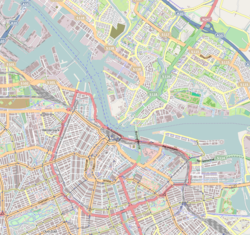
The State Hermitage Museum is a museum of art and culture in Saint Petersburg, Russia. The second-largest art museum in the world, it was founded in 1764 when Empress Catherine the Great acquired an impressive collection of paintings from the Berlin merchant Johann Ernst Gotzkowsky. The museum celebrates the anniversary of its founding each year on 7 December, Saint Catherine's Day. It has been open to the public since 1852. It attracted 968,604 visitors in 2020, a drop of eighty percent from 2019, due to the COVID-19 pandemic. In 2020 it ranked eleventh on the List of most visited art museums in the world.

Jacob de Wit was a Dutch artist and interior decorator who painted many religious scenes.
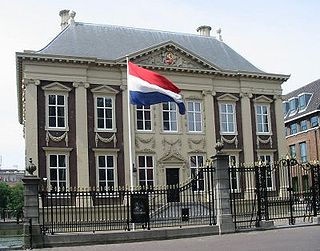
Jacob van Campen, was a Dutch artist and architect of the Golden Age.
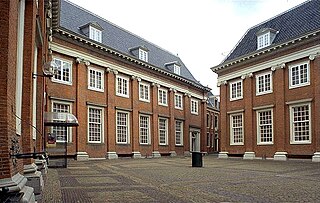
The Amsterdam Museum, until 2011 called the Amsterdams Historisch Museum, is a museum about the history of Amsterdam. Since 1975, it is located in the old city orphanage between Kalverstraat and Nieuwezijds Voorburgwal.
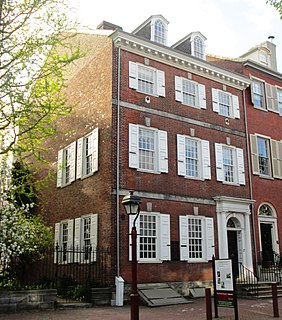
The Powel House is a historic house museum located at 244 South 3rd Street, between Willings Alley and Spruce Street, in the Society Hill neighborhood of Philadelphia, Pennsylvania. Built in 1765 in the Georgian style, and embellished by second owner Samuel Powel (1738–1793), it has been called "the finest Georgian row house in the city." As with other houses of this type, the exterior facade is understated and simple, but the interior was elaborately appointed.

Gerard or Gérard (de) Lairesse was a Dutch Golden Age painter and art theorist. His broad range of skills included music, poetry, and theatre. De Lairesse was influenced by the Perugian Cesare Ripa and French classicist painters such as Charles le Brun, Simon Vouet and authors such as Pierre Corneille and Jean Racine. His importance grew in the period following the death of Rembrandt. His treatises on painting and drawing, Grondlegginge Ter Teekenkonst (1701), based on geometry and Groot Schilderboek (1707), were highly influential on 18th-century painters.

Museum Geelvinck Hinlopen Huis was situated from its opening 1991 till the end of 2015 in a canal-side mansion, the Geelvinck Hinlopen Huis in Amsterdam, the Netherlands. This patrician mansion, close to the Rembrandtplein, was built for Albert Geelvinck (1647-1693) and Sara Hinlopen (1660-1749), then in an attractive and new laid-out section of the city towards the Amstel. In the year 1687 the couple moved into this double wide house, with storage rooms in the cellar, under the attic and in the warehouse on Keizersgracht 633, now the entrance.
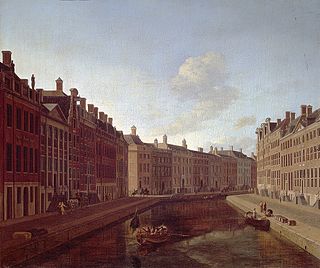
The Herengracht is the second of four Amsterdam canals belonging to the canal belt and lies between the Singel and the Keizersgracht. The Gouden Bocht in particular is known for its large and beautiful canal houses.

Palazzo Davanzati is a palace in Florence, Italy. It houses the Museum of the Old Florentine House.
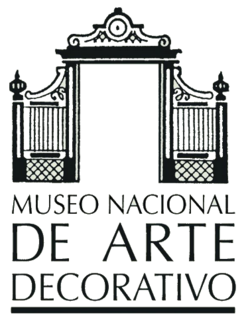
The National Museum of Decorative Arts is an art museum in Recoleta, Buenos Aires, Argentina.

A canal house is a house overlooking a canal. These houses are often slim, high and deep. Because of the danger of flooding the front door is sometimes higher up and only accessible via stairs. The floor of the main storey lies about seven to nine steps above street level. Many stoops disappeared in the 19th century when entrances were moved to the basement.
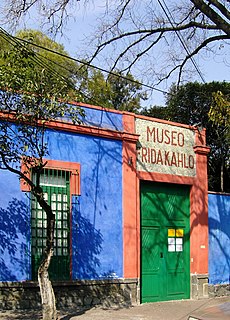
The Frida Kahlo Museum, also known as the Blue House for the structure's cobalt-blue walls, is a historic house museum and art museum dedicated to the life and work of Mexican artist Frida Kahlo. It is located in the Colonia del Carmen neighborhood of Coyoacán in Mexico City. The building was Kahlo's birthplace, the home where she grew up, lived with her husband Diego Rivera for a number of years, and where she later died in a room on the upper floor. In 1957, Diego Rivera donated the home and its contents in order to turn it into a museum in Frida's honor.

The Namık Kemal House Museum is a historic house museum in Tekirdağ, northwestern Turkey devoted to the life and works of Namık Kemal (1840–1888), Turkish nationalist poet. It is a rebuilt 19th-century house, which was transformed 1993 into a museum.

Rode Hall, a Georgian country house, is the seat of the Wilbraham family, members of the landed gentry in the parish of Odd Rode, Cheshire, England. The estate, with the original timber-framed manor house, was purchased by the Wilbrahams from the ancient Rode family in 1669. The medieval manor house was replaced between 1700 and 1708 by a brick-built seven-bay building; a second building, with five bays, was built in 1752; the two buildings being joined together in 1800 to form the present Rode Hall.
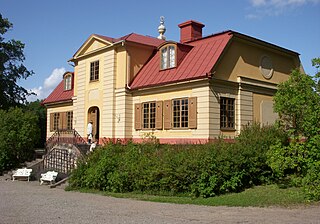
Svindersvik is a well-preserved 18th century country residence in Nacka Municipality, Sweden. Svindersvik lies just outside the city limits of Stockholm. It was built in the 1740s for Claes Grill, and today belongs to the Nordic Museum. It is open to the public through guided tours.
Nicola Monachesi (1795–1851) was an Italian painter believed to have painted the earliest frescos in America. He was born in Tolentino, Marche Italy and was considered a citizen of Rome. When he died in Philadelphia, he had become a naturalized citizen of the United States. In Italy he was a pupil of the Accademia di San Luca, Rome, studying under Gaspare Landi, and won his first prize for painting. After studying in Rome, he emigrated to America in 1831-32 entering through New York and settling in Philadelphia. He worked mostly as an interior decorator, drawing neoclassical artistic paintings on wall surfaces and portrait paintings on canvass decorating churches, commercial buildings, and Mansions.
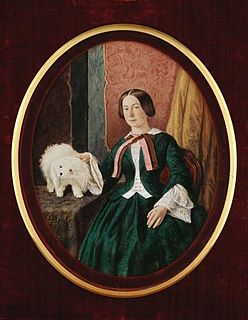
Sandrina Louisa Geertruida Holthuysen was a Dutch art collector and founder of the Museum Willet-Holthuysen in Amsterdam.

Children Playing with a Goat is an 18th-century grisaille painting in the style of Jacob de Wit, known as a "witje". It shows a relief of children playing with a goat after a relief by Francois Duquesnoy. It is in the collection of the Metropolitan Museum of Art.
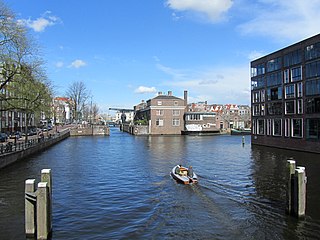
The Nieuwe Herengracht is a canal in Centrum district of Amsterdam. The canal is an extension of the Herengracht that runs between the Amstel and the Scharrebiersluis (lock) leading to the Schippersgracht from the Entrepotdok. It is in the Plantage neighborhood in the eastern part of the Grachtengordel.

Casparis Haanen was a Dutch painter, papercutter and draftsman.

